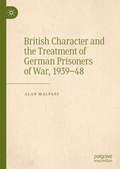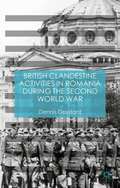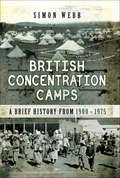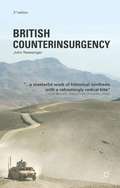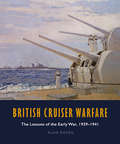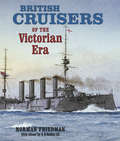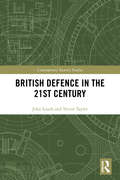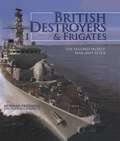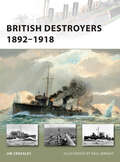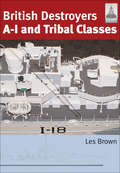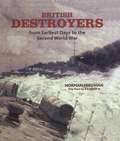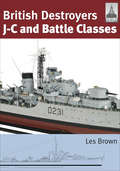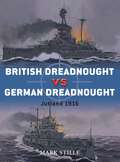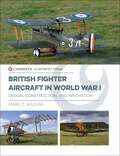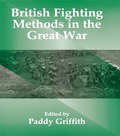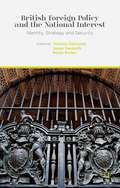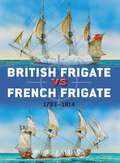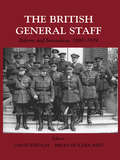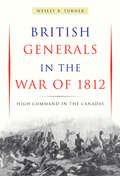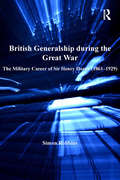- Table View
- List View
British Character and the Treatment of German Prisoners of War, 1939–48
by Alan MalpassThis book examines attitudes towards German held captive in Britain, drawing on original archival material including newspaper and newsreel content, diaries, sociological surveys and opinion polls, as well as official documentation and the archives of pressure groups and protest movements. Moving beyond conventional assessments of POW treatment which have focused on the development of policy, diplomatic relations, and the experience of the POWs themselves, this study refocuses the debate onto the attitude of the British public towards the standard of treatment of German POWs. In so doing, it reveals that the issue of POW treatment intersected with discussions of state power, human rights, gender relations, civility, and national character.
British Clandestine Activities in Romania during the Second World War
by Dennis DeletantBritish Clandestine Activities in Romania during the Second World War is the first monograph to examine the activity throughout the entire war of SOE and MI6. It was generally believed in Britain's War Office, after Hitler's occupation of Austria in March 1938, that Germany would seek to impose its will on South-East Europe before turning its attention towards Western Europe. Given Romania's geographical position, there was little Britain could offer her. The brutal fact of British-Romanian relations was that Germany was inconveniently in the way: opportunity, proximity of manufacture and the logistics of supply all told in favour of the Third Reich. This held, of course, for military as well as economic matters. In these circumstances the British concluded that their only weapon against German ambitions in countries which fell into Hitler's orbit were military subversive operations and a concomitant attempt to draw Romania out of her alliance with Germany.
British Concentration Camps: A Brief History from 1900–1975
by Simon WebbThis revealing history explores Britain&’s use of concentration camps from the Boer War to WWII and the Troubles in Northern Ireland. The term concentration camp will forever be associated with the horrors of Nazi Germany. But the British were the true driving force behind the development of these notorious facilities. During the Boer War, British concentration camps caused the deaths of tens of thousands of children from starvation and disease. In the years after World War II, hundreds of thousands of enslaved agricultural workers were held in a national network of camps. Not only did the British government run its own camps, they allowed other countries to set up similar facilities within the United Kingdom. During and after the Second World War, the Polish government-in-exile maintained a number of camps in Scotland where Jews, communists and homosexuals were imprisoned and sometimes killed. This book tells the terrible story of Britain&’s involvement in the use of concentration camps, which did not finally end until the last political prisoners being held behind barbed wire in the United Kingdom were released in 1975. From England to Cyprus, Scotland to Malaya, Kenya to Northern Ireland, British Concentration Camps: A Brief History from 1900 to 1975 details some of the most shocking and least known events in British history.
British Counterinsurgency
by John NewsingerBritish Counterinsurgency challenges the British Army's claim to counterinsurgency expertise. It provides well-written, accessible and up-to-date accounts of the post-1945 campaigns in Palestine, Malaya, Kenya, Cyprus, South Yemen, Dhofar, Northern Ireland and more recently in Iraq and Afghanistan.
British Cruiser Warfare: The Lessons of the Early War, 1939–1941
by Alan Raven&“An outstanding contribution to the historiography of the Second World War at sea . . . . an excellent book.&” —The Australian Naval Institute Cruisers were the Navy&’s maids-of-all-work, employed in a greater variety of roles than any other warship type. Smaller, faster, and far more numerous than battleships, they could be risked in situations where capital ships were too vulnerable, while still providing heavy gunfire support for smaller ships or anti-aircraft cover for the fleet. As such, they were in the frontline of the naval war from the outset—and from its first days, the fighting provided unexpected challenges and some very unpleasant surprises, not least the efficacy of air power. Cruisers learned to deal with these new realities in the Norway campaign and later in the Mediterranean, partly through the introduction of new technology—notably radar—but also by codifying the hard-won experience of those involved. This highly original book analyses the first years of the war when the sharpest lessons were learned, initially describing every action and its results, and then summarizing in individual chapters the conclusions that could be drawn for the many aspects of a cruiser&’s duties. These include the main roles like surface gunnery, shore bombardment, anti-aircraft tactics, and fighter direction, but also encompass technology like radar, ASDIC, and shipborne aircraft, and even tackle more human issues such as shipboard organization, damage control, the impact of weather, and the morale factor. It also attempts to evaluate the importance of electronic warfare, intelligence and code-breaking, and concludes with a comparison between the performance of British cruisers and their Italian and German opponents. Thought-provoking and sometimes controversial, this is a book that should be read by everyone interested in the Second World War at sea. Includes maps and photos
British Cruisers of the Victorian Era
by Norman FriedmanGradually evolving from the masted steam frigates of the mid-nineteenth century, the first modern cruiser is not easy to define, but for the sake of this book the starting point is taken to be Iris and Mercury of 1875. They were the RN's first steel-built warships; were designed primarily to be steamed rather than sailed; and formed the basis of a line of succeeding cruiser classes. The story ends with the last armoured cruisers, which were succeeded by the first battlecruisers (originally called armoured cruisers), and with the last Third Class Cruisers (Topaze class), all conceived before 1906. Coverage, therefore, dovetails precisely with Friedman's previous book on British cruisers, although this one also includes the wartime experience of the earlier ships.rn The two central themes are cruisers for the fleet and cruisers for overseas operations, including (but not limited to) trade protection. The distant-waters aspect covers the belted cruisers, which were nearly capital ships, intended to deal with foreign second-class battleships in the Far East. The main enemies contemplated during this period were France and Russia, and the book includes British assessments of their strength and intentions, with judgements as to how accurate those assessments were.rn As would be expected of Friedman, the book is deeply researched, original in its analysis, and full of striking insights another major contribution to the history of British warships.
British Cruisers: Two World Wars and After
by Norman Friedman&“An extraordinarily detailed account of the development of Royal Navy cruisers . . . a towering work&” from the author of Fighting the Great War at Sea (Warship 2012). For most of the twentieth century, Britain possessed both the world&’s largest merchant fleet and its most extensive overseas territories. It is not surprising, therefore, that the Royal Navy always showed a particular interest in the cruiser—a multipurpose warship needed in large numbers to defend trade routes and police the empire. Above all other types, the cruiser&’s competing demands of quality and quantity placed a heavy burden on designers, and for most of the interwar period, Britain sought to square this circle through international treaties restricting both size and numbers. In the process, she virtually invented the heavy cruiser and inspired the large 6in-armed cruiser, neither of which, ironically, served her best interests. This book seeks to comprehend, for the first time, the full policy background—from which a different and entirely original picture of British cruiser development emerges. After the war, the cruiser&’s role was reconsidered, and the final chapters of the book cover modernizations, the plans for missile-armed ships, and the convoluted process that turned the &“through-deck cruiser&” into the Invincible class light carriers. With detailed appendices of ship data, and illustrated in depth with photos and A.D. Baker&’s specially commissioned plans, British Cruisers truly matches the lofty standards set by Friedman&’s previous books on British destroyers. &“Wow! . . . Lavishly illustrated with a photograph or line plan on almost every page. The text is packed with technical information, detail, and description of design, construction and application of these important ships.&” —Clash of Steel
British Cyprus and the Long Great War, 1914-1925: Empire, Loyalties and Democratic Deficit (Routledge Studies in First World War History)
by Andrekos VarnavaMost of the Cypriot population, especially the lower classes, remained loyal to the British cause during the Great War and the island contributed significantly to the First World War, with men and materials. The British acknowledged this yet failed to institute political and economic reforms once the war ended. The obsession of Greek Cypriot elites with enosis (union with Greece), which only increased after the war, and the British dismissal of increasing the role of Cypriots in government, bringing the Christian and Muslim communities closer, and expanding franchise to all classes and sexes, led to serious problems down the line, not least the development of a democratic deficit. Andrekos Varnava studies the events and the impact of this crucial period.
British Defence in the 21st Century (Contemporary Security Studies)
by Trevor Taylor John LouthThis book analyses UK defence as a complex, interdependent public-private enterprise covering politics, management, society, and technology, as well as the military. Building upon wide-ranging applied research, with extensive access to ministers, policy makers, senior military commanders, and industrialists, the book characterises British defence as a phenomenon that has endured extensive transformation this century. Looking at the subject afresh as a complex, extended enterprise involving politics, alliances, businesses, skills, economics, military practices, and citizens, the authors profoundly reshape our understanding of ‘defence’ and how it is to be commissioned and delivered in a world dominated by geopolitical risks and uncertainties. The book makes the case that this new understanding of defence must inevitably lead to new policies and processes to ensure its health and vitality. This book will be of much interest to students of defence studies, British politics, and military and strategic studies, as well as policy makers and practitioners.
British Destroyers & Frigates: The Second World War & After
by Norman Friedman&“A comprehensive survey of the design history and development of the Royal Navy's greyhounds of the sea.&”—WARSHIPS Magazine Since World War II, the old categories of destroyer and frigate have tended to merge, a process that this book traces back to the radically different &“Tribal&” class destroyers of 1936. It deals with the development of all the modern destroyer classes that fought the war, looks at the emergency programs that produced vast numbers of trade protection vessels—sloops, corvettes and frigates—then analyzes the pressures that shaped the post-war fleet, and continued to dominate design down to recent years. Written by America's leading authority and featuring photos and ship plans, it is an objective but sympathetic view of the difficult economic and political environment in which British designers had to work, and benefits from the author's ability to compare and contrast the US Navy's experience. Norman Friedman is renowned for his ability to explain the policy and strategy changes that drive design decisions, and his latest book uses previously unpublished material to draw a new and convincing picture of British naval policy over the previous seventy years and more. Includes photos
British Destroyers 1892-1918
by Paul Wright Jim CrossleyThis book recounts the history of the first destroyers of the Royal Navy, which revolutionised this service and changed the way war was fought at sea. Moreover, between 1892, when the first destroyers were laid down, and 1918 destroyers evolved radically from 27 knot, 250-ton ships into 35 knot, 1,530-ton ships. All these ships were involved in some form during World War I; the smaller, original destroyers in an auxiliary support role and the newer larger destroyers at some of the greatest sea battles of the war. Indeed, this book will highlight the role destroyers played in the North Sea during the crucial battles to control the Heliogoland Bight as well as the major fleet action at the battle of Jutland in 1916. Complete with a detailed description of the technical evolution of each class of destroyer from the 27-knotters to the Tribal and Marksman classes, this book offers a complete overview of the vessels that helped to maintain Britain's supremacy at sea.
British Destroyers A-I and Tribal Classes: A-i And Tribal Classes (Shipcraft Ser. #Vol. 11)
by Les BrownThe 'ShipCraft' series provides in-depth information about building and modifying model kits of famous warship types. Lavishly illustrated, each book takes the modeller through a brief history of the subject class, then moves to an extensive photographic survey of either a high-quality model or a surviving example of the ship. Hints on building the model, and on modifying and improving the basic kit, are followed by a section on paint schemes and camouflage, featuring numerous colour profiles and highly-detailed line drawings. The strengths and weaknesses of available kits of the ships are reviewed, and the book concludes with a section on research references—books, monographs, large-scale plans and relevant websites.This new volume deals with the classes which represent the whole inter-war development of British destroyers, from the prototypes Amazon and Ambuscade of 1926—the first new post World War I design—to the powerful and radically different 'Tribal' class a decade later. These ships formed the backbone of Royal Navy destroyer flotillas in the Second World War.
British Destroyers: From Earliest Days to the Second World War
by Norman FriedmanA history of the early days of Royal Navy destroyers, and how they evolved to meet new military threats. In the late nineteenth century the advent of the modern torpedo woke the Royal Navy to a potent threat to its domination, not seriously challenged since Trafalgar. For the first time a relatively cheap weapon had the potential to sink the largest, and costliest, exponents of sea power. Not surprisingly, Britain&’s traditional rivals invested heavily in the new technology that promised to overthrow the naval status quo. The Royal Navy was also quick to adopt the new weapon, but the British concentrated on developing counters to the essentially offensive tactics associated with torpedo-carrying small craft. From these efforts came torpedo catchers, torpedo-gunboats and eventually the torpedo-boat destroyer, a type so successful that it eclipsed and then usurped the torpedo-boat itself. With its title shortened to destroyer, the type evolved rapidly and was soon in service in many navies, but in none was the evolution as rapid or as radical as in the Royal Navy. This book is the first detailed study of their early days, combining technical history with an appreciation of the changing role of destroyers and the tactics of their deployment. Like all of Norman Friedman&’s books, it reveals the rationale and not just the process of important technological developments.
British Destroyers: J-c And Battle Classes (Shipcraft Ser. #21)
by Les Brown&“A terrific author . . . invaluable to the modeler wishing to reproduce these classes of destroyers, and also to those interested in naval history.&”—IPMS Magazine The ShipCraft series provides in-depth information about building and modifying model kits of famous warship types. Lavishly illustrated, each book takes the modeler through a brief history of the subject class, highlighting differences between sisterships and changes in their appearance over their careers. This includes paint schemes and camouflage, featuring color profiles and highly detailed line drawings and scale plans. The modeling section reviews the strengths and weaknesses of available kits, lists commercial accessory sets for super-detailing of the ships, and provides hints on modifying and improving the basic kit. This is followed by an extensive photographic survey of selected high-quality models in a variety of scales, and the book concludes with a section on research references—books, monographs, large-scale plans and relevant websites. A follow-up to ShipCraft 11 on inter-war destroyers, this new volume deals with the later classes which were the most modern British destroyers of the Second World War. Marked by a common single-funneled silhouette, they were actually very varied, ranging from the large and powerful J to N flotillas, via the austere &“War Emergency&” classes that were built in large numbers, to the radically different &“Battle&” class, designed with a powerful AA armament for service in the Pacific. &“This book will be of interest to those who want an easy reference book that covers the British and Australian destroyers of this period, especially with regard to camouflage and overall appearance in service.&”—Australian Naval Institute
British Dreadnought vs German Dreadnought
by Ian Palmer Mark StilleIn 1916, in the seas near Jutland, two fleets of armoured dreadnoughts met in open battle. This book tells the story of the British and German battleships of these two great fleets - from their development as the first generation of fully- armoured warships - to their combat experiences. The differing weapon systems and crew training of the British and German fleets are examined in detail, as is the titanic struggle of Jutland, through an hour-by-hour, shot-by-shot, reconstruction. Finally, it analyzes the outcome of the struggle, explaining the successes and failures of these great battleships.From the Trade Paperback edition.
British Exploitation of German Science and Technology, 1943-1949: The Spoils of War (Routledge Studies in Second World War History)
by Charlie HallAt the end of the Second World War, Germany lay at the mercy of its occupiers, all of whom launched programmes of scientific and technological exploitation. Each occupying nation sought to bolster their own armouries and industries with the spoils of war, and Britain was no exception. Shrouded in secrecy yet directed at the top levels of government and driven by ingenuity from across the civil service and armed forces, Britain made exploitation a key priority. By examining factories and laboratories, confiscating prototypes and blueprints, and interrogating and even recruiting German experts, Britain sought to utilise the innovations of the last war to prepare for the next. This ground-breaking book tells the full story of British exploitation for the first time, sheds new light on the legacies of the Second World War, and contributes to histories of intelligence, science, warfare and power in the midst of the twentieth century.
British Fighter Aircraft in World War I: Design, Construction, and Innovation (Casemate Illustrated Special)
by Mark C. WilkinsA vivid pictorial history: &“Buy this book right now. It is rare that ISD gives an instant five-star rating to any new volume, but [this] is a rare book.&” —Indy Squadron Dispatch World War I witnessed unprecedented growth and innovation in aircraft design, construction, and—as the war progressed—mass production. Each country generated its own innovations, sometimes in surprising ways—Albatros Fokker, Pfalz, and Junkers in Germany and Nieuport, Spad, Sopwith, and Bristol in France and Britain. This book focuses on the British approach to fighter design, construction, and mass production. Initially the French led the way in Allied fighter development with their Bleriot trainers, then nimble Nieuport Scouts—culminating with the powerful, fast gun platforms as exemplified by the Spads. The Spads had a major drawback however, in that they were difficult and counterintuitive to fix in the field. The British developed fighters in a very different way; Tommy Sopwith had a distinctive approach to fighter design that relied on lightly loaded wings and simple functional box-girder fuselages. His Camel was revolutionary as it combined all the weight well forward, enabling the Camel to turn very quickly—but also making it an unforgiving fighter for the inexperienced. The Royal Aircraft Factory&’s SE5a represented another leap forward with its comfortable cockpit, modern instrumentation, and inline engine—clearly influenced by both Spads and German aircraft. Each manufacturer and design team vied for the upper hand and deftly and quickly appropriated good ideas from other companies—be they friend or foe. Developments in tactics and deployment also influenced design—from the early reconnaissance planes, to turn fighters, and finally planes that relied upon formation tactics, speed, and firepower. This book tells their story through extensive photos and accompanying text. &“Handy not only as an aircraft model reference, but also as great reading for all history fans.&” —DetailScaleView &“Sidebars add important information at the proper place.&” —Air Power History
British Fighting Methods in the Great War
by Paddy GriffithThis collection points out the very real and substantial evolution of tactics that went on in response to new warfare and how this had a real effect on the positive performance of the British Army from 1916 onwards.
British Foreign Policy and the National Interest
by Jamie Gaskarth Robin Porter Timothy EdmundsWhose interests does British foreign policy serve? Is the national interest a useful explanatory tool for foreign policy analysts? This interdisciplinary collection responds to these questions exploring ideas of Britain's national interest and their impact on strategy, challenging current thinking and practice in the making of foreign policy.
British Frigate vs French Frigate
by Peter Dennis Mark LardasIn the Age of Fighting Sail (1650-1820), ambitious officers of the navies of many nations sought command of a frigate. Speedy, nimble and formidably armed, frigates often operated independently, unlike the larger ships of the line. Legendary sailors such as Edward Pellew and Charles-Alexandre Léon Durand, Comte de Linoise, found that commanding such a ship offered numerous opportunities for wealth - in the form of prize money paid out for captured enemy vessels - and, even more importantly, prestige and promotion for captains who prevailed in the numerous single-ship duels that characterized frigate warfare. During in the Revolutionary and Napoleonic Wars both Great Britain and France employed frigates to achieve their maritime objectives: to perpetuate its supremacy the Royal Navy needed to be strong everywhere, while the French Navy concentrated its efforts on deploying single frigates or small frigate squadrons to probe for weak points in the British mastery of the seas. Between 1793, when HMS Nymphe fought and captured the French frigate La Cléopâtre, and the 1814 clash between HMS Hebrus and L'Étoile British and French frigates met and fought in over 100 battles. Of these no fewer than 32 were pure frigate duels, with a pair of frigates fighting without the interference of another major warship before the battle ended. Attention and romance attached to these clashes, both at the time and right up to the present day; literary characters such as Horatio Hornblower and Jack Aubrey have perpetuated the legend of these spirited battles on the high seas for successive generations. In this book, four representative frigate duels are examined: first, a battle fought between two closely matched ships (HMS Nymphe (36) vs La Cléopâtre (32), 18 June 1793); second, a victory won by an inferior British frigate over a superior French frigate (HMS Pallas (32) vs Minerve (40), 14 May 1806); third, a victory - the only one - by an inferior French frigate over a superior British frigate (HMS Ambuscade (32) vs Baïonnaise (24), 14 December 1798), and fourth, victory of a superior British frigate over an inferior French frigate (HMS Indefatigable (44) of Hornblower fame vs La Virginie (40), 21 April 1796). Featuring specially commissioned artwork and offering expert analysis, this study provides a vivid account of the bloody combats fought by the most romantic warship of the Revolutionary and Napoleonic era - the frigate.
British General Staff: Reform and Innovation (Military History and Policy #No. 10)
by Brian Holden Reid David FrenchThe essays that comprise this collection examine the development and influence of the British General Staff from the late Victorian period until the eve of World War II. They trace the changes in the staff that influenced British military strategy and subsequent operations on the battlefield.
British Generals in Blair's Wars (Military Strategy and Operational Art)
by Jonathan Bailey Richard IronBritish Generals in Blair's Wars is based on a series of high profile seminars held in Oxford in which senior British officers, predominantly from the army, reflect on their experience of campaigning. The chapters embrace all the UK's major operations since the end of the Cold War, but they focus particularly on Iraq and Afghanistan. As personal testimonies, they capture the immediacy of the authors' thoughts at the time, and show how the ideas of a generation of senior British officers developed in a period of rapid change, against a background of intense political controversy and some popular unease. The armed forces were struggling to revise their Cold War concepts and doctrines, and to find the best ways to meet the demands placed upon them by their political leaders in what was seen to be a 'New World Order'. It was a time when relations between the Government of the day and the armed services came under close scrutiny, and when the affection of the British public for its forces seemed to grow with the difficulty of their operational tasks. This is a truly unique and invaluable book. For the first time, we are offered first-hand testimony about Britain's involvement in recent campaigns by senior participants. In addition to touching on themes like civilian-military relations, the operational direction of war and relationships with allies, these eyewitness accounts give a real sense of how the character of a war changes even as it is being fought. It will be essential reading for those in military academies and staff colleges, not only in Britain but throughout NATO, and especially in the USA. It also has profound policy implications, as both the UK and NATO more generally reassess their strategies and the value of intervention operations. It will also become a primary source for historians and students of the wars, in Iraq and Afghanistan in particular.
British Generals in the War of 1812
by Wesley B. TurnerIn British Generals in the War of 1812 Wesley Turner takes a fresh look at five British Generals - Sir George Prevost, Isaac Brock, Roger Sheaffe, Baron Francis de Rottenburg, and Gordon Drummond - who held the highest civil and military command in the Canadas. He considers their formative experiences in the British Army and on active service in European and West Indian theatres and evaluates their roles in the context of North American conditions, which were very different from those of Europe. Wesley Turner answers questions about the quality of each general's leadership, particularly that of Isaac Brock, the best known of these five generals. He argues that Brock's charge up Queenston Heights - the basis for his heroic stature - was brave but hardly a demonstration of competent leadership. Turner also shows us that while the other generals displayed courage in combat, they had to face problems raised by American military successes and by the strains of warfare on the civilian population. British Generals in the War of 1812 explores why these commanders succeeded or failed and why, except for Brock, they are all but forgotten.
British Generals in the War of 1812: High Command in the Canadas
by Wesley B. TurnerIn British Generals in the War of 1812 Wesley Turner takes a fresh look at five British Generals - Sir George Prevost, Isaac Brock, Roger Sheaffe, Baron Francis de Rottenburg, and Gordon Drummond - who held the highest civil and military command in the Canadas. He considers their formative experiences in the British Army and on active service in European and West Indian theatres and evaluates their roles in the context of North American conditions, which were very different from those of Europe. Turner answers questions about the quality of each general's leadership, particularly that of Isaac Brock, the best known of these five generals. He argues that Brock's charge up Queenston Heights - the basis for his heroic stature - was brave but hardly a demonstration of competent leadership. Turner also shows us that while the other generals displayed courage in combat, they had to face problems raised by American military successes and by the strains of warfare on the civilian population. British Generals in the War of 1812 explores why these commanders succeeded or failed and why, except for Brock, they are all but forgotten.
British Generalship during the Great War: The Military Career of Sir Henry Horne (1861–1929) (Routledge Studies in First World War History)
by Simon RobbinsFollowing the career of one relatively unknown First World War general, Lord Horne, this book adds to the growing literature that challenges long-held assumptions that the First World War was a senseless bloodbath conducted by unimaginative and incompetent generals. Instead it demonstrates that men like Horne developed new tactics and techniques to deal with the novel problems of trench warfare and in so doing seeks to re-establish the image of the British generals and explain the reasons for the failures of 1915-16 and the successes of 1917-18 and how this remarkable change in performance was achieved by a much maligned group of senior officers. Horne's important career and remarkable character sheds light not only on the major battles in which he was involved; the progress of the war; his relationships with his staff and other senior officers; the novel problems of trench warfare; the assimilation of new weapons, tactics and training methods; and the difficulties posed by the German defences, but also on the attitudes and professionalism of a senior British commander serving on the Western Front. Horne's career thus provides a vehicle for studying the performance of the British Army in the first quarter of the Twentieth Century. It also gives an important insight into the attitudes, ethos and professionalism of the officer corps which led that army to victory on the Western Front, exposing not only its flaws but also its many strengths. This study consequently provides a judgment not only on Horne as a personality, innovator and general of great importance but also on his contemporaries who served with the British Armies in South Africa and France during an era which saw a revolution in military affairs giving birth to a Modern Style of Warfare which still prevails to this day.
